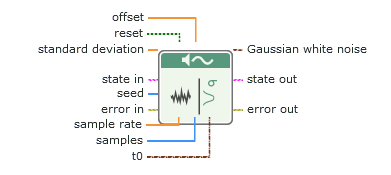Gaussian
- Updated2023-02-17
- 6 minute(s) read
Gaussian
Generates a signal containing a Gaussian white noise wave.

Inputs/Outputs

offset
DC offset of the signal.
Default value: 0

reset
A Boolean that controls the reseeding of the noise sample generator after the first call of the node.
| True | Accepts a new state or new seed value and begins producing noise samples based on the new state or new seed value. |
| False | Maintains the initial internal seed state and resumes producing noise samples as a continuation of the previous noise sequence. |
Default value: False

standard deviation
Standard deviation of the noise you generate.
Default value: 1

state in
Initial internal state of the noise generator.
This input must be passed from the state out output of another call to this node.
This node uses state in as the initial internal seed state of the noise generator if reset is True or if this is the first call of the node. If state in contains invalid values, this nodes uses seed as the initial internal seed state of the noise generator.

random generator state
Initial internal seed state of the random noise generator.

x seed
Internal x seed.

y seed
Internal y seed.

z seed
Internal z seed.

Gauss state
Internal Gauss state.

normal preset
Normal preset state for internal use.

normal preset value
Normal preset value for internal use.

seed
Number that this node uses to initialize the noise generator.
This node initializes the noise generator using seed when this node meets both of the following conditions:
- This is the first call of this node or reset is True.
- state in is unwired or contains invalid values.
| seed is greater than 0 | Generates noise samples based on the seed value. |
| seed is less than or equal to 0 | For the first call, this node generates a random seed value and produces noise samples based on that seed value. For subsequent calls to the node, if seed remains less than or equal to 0, the node maintains the initial internal seed state and produces noise samples as a continuation of the initial noise sequence. |
Default value: -1

error in
Error conditions that occur before this node runs.
The node responds to this input according to standard error behavior.
Default value: No error

sample rate
Sample rate in samples per second.
This input is available only if you configure this node to return a waveform.
Default value: 1000

samples
Number of samples in the signal.
samples must be greater than 0. Otherwise, this node returns an error.
This input is available when you configure this node to return a waveform or an array of double-precision, floating-point numbers.
Default value: 1000

t0
Timestamp of the output signal.
This input is available only if you configure this node to return a waveform.

Gaussian white noise
Gaussian-distributed, pseudorandom pattern.
This output can return the following data types:
- Waveform
- Double-precision, floating-point number
- 1D array of double-precision, floating-point numbers

state out
Final internal seed state of the noise generator.

random generator state
Final internal seed state of the random noise generator.

x seed
Internal x seed.

y seed
Internal y seed.

z seed
Internal z seed.

Gauss state
Internal Gauss state.

normal preset
Normal preset state for internal use.

normal preset value
Normal preset value for internal use.

error out
Error information.
The node produces this output according to standard error behavior.
Algorithm for Generating the Gaussian White Noise
This node generates the Gaussian-distributed pseudorandom sequence using a modified version of the Box-Muller method to transform uniformly distributed random numbers into Gaussian-distributed random numbers. This node generates the uniform pseudorandom numbers using the Wichmann-Hill generator. Given that the probability density function, f(x), of the Gaussian-distributed Gaussian noise pattern is
where s is the absolute value of standard deviation. You can compute the expected values,
, using the following formula:The following equations define the expected mean value
and the expected standard deviation value of the pseudorandom sequence:The pseudorandom sequence produces approximately 6.95 * 1012 samples before the pattern repeats itself. The probability density function (PDF) of the pseudorandom sequence approximates a Gaussian PDF with peak values of at least 6
.Application of the Gaussian White Noise
Gaussian white noise provides a realistic simulation of some real-world situations. Because of its independent statistical characteristics, Gaussian white noise also often acts as the source of other random number generators. The additive white Gaussian noise (AWGN) channel model is widely used in communications.